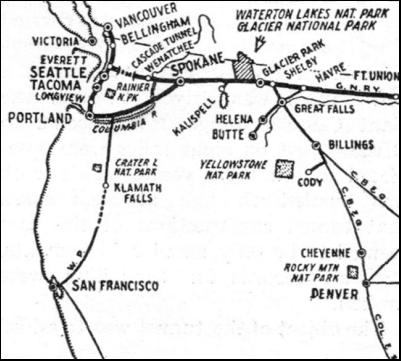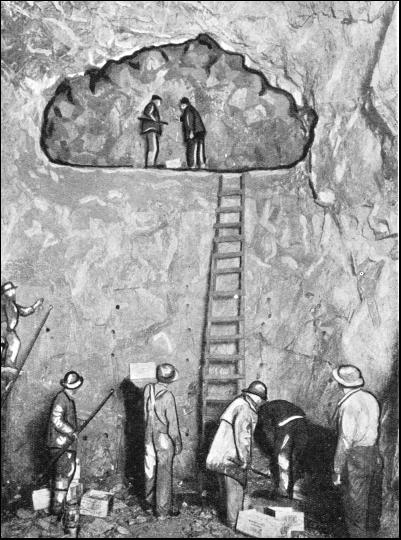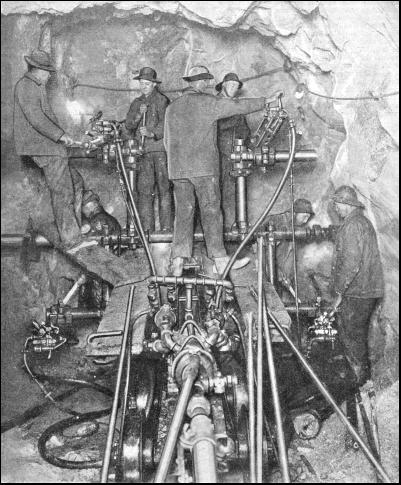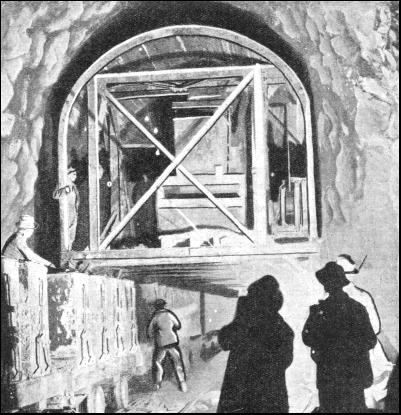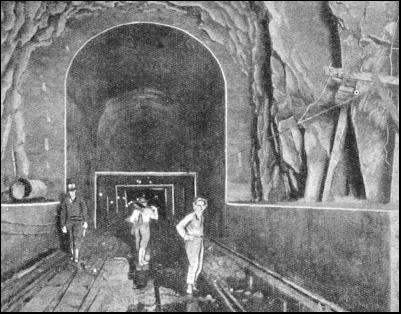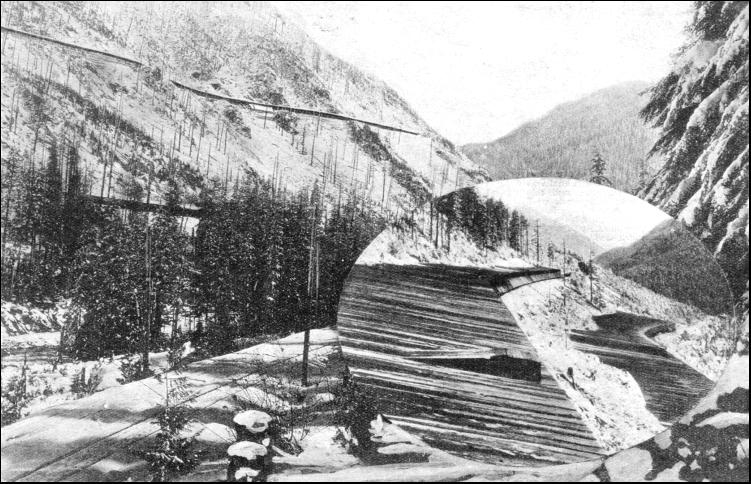|
|
ONE of the most amazing engineering feats of recent years was carried out on the system of the Great Northern Railway of America when a new tunnel was driven through the giant Cascade range from Scenic to Berne. Just on eight miles were completed within three years. This work was hustled through at such speed that tunnel constructions of the past seemed to be only small achievements, and all records for tunnelling were broken. The object of the tunnel was to afford Seattle, on the Pacific Coast, more direct and easier communication with the cities in West and Central America. By the building of the Cascade Tunnel the railway company secured absolute protection from the peril of avalanches and eliminated the cost of maintaining snow-sheds to guard the track. The main line route was shortened by seven and a half miles, while the curves and gradients were also considerably reduced. In 1925 parties of engineers set out to survey the site. Owing to the length of the tunnel it was imperative that the work should proceed from more than two sides, and the surveyors decided that a shaft should be sunk in Mill Creek valley above the line of the tunnel Other problems of preliminary investigation were the location of the tunnel's axis, the estimation of the difference in elevation between the east portal and the west portal, and the depth of the Mill Creek shaft.
The surveys were carried out in the heart of winter over a bleak and mountainous district, but, despite blizzards and snowstorms, the calculations proved to be extremely accurate. Two weeks after the undertaking had been approved and handed over to the contractors, tunnelling began at a camp on the western side of the Cascades. And it was not long before three modern construction camps had been erected, two at either end and one in the middle at Mill Creek where the sinking of the shaft to the proposed level of the tunnel had begun. Most of the vast amount of the tunnel-boring machinery had also been transported into the wilderness of this rugged district. The difficulties that confronted the engineers were the seemingly impossible time limit imposed—a bare three years to construct and finish eight miles of tunnel—the probability of striking subterranean streams, and the uncertainty as to the nature of the rock and soil likely to be encountered during boring operations. The time restrictions, in addition to the length of the tunnel, also made it necessary to begin work at several different places simultaneously, for it was quite clear that only a relatively small number of men and machines could concentrate at the east and west entrances. The construction of the Mill Creek shaft, two and half miles from the east portal, afforded two additional working faces. When in August, 1926, Mill Creek shaft was completed, great skips were erected at the mouth to haul up the spoil from the excavations. Pumps were also installed in readiness to deal with any water that might be encountered. Light contractors' engines for hauling rock, power shovels, drills and mechanical excavators (which were to assist both in the building of the main and the pioneer tunnels) were lowered down into the earth. The pioneer tunnel, 8 ft. by 9 ft., was begun in two places at once, eastwards from the entrance at Berne, and also at Mill Creek shaft. Work on these two sections of the pioneer tunnel, which met over two years later, proceeded in conjunction with work on the main tunnel through which one day the railway would run. As the dimensions of the pioneer tunnel were considerably less than those of the main one, it was always well in advance of the headings of the major operation. Cross-cuts were hewn from the pioneer tunnel into the path of the approaching main tunnel. This procedure made it possible for the constructors to keep the work going at several faces. Other important problems were also solved by this pioneer tunnel method. The small tunnel was used to drain away water from the large one. Through it ran the light trains, carrying labourers and supplies, and the rock hewn from the faces reached by the cross-cuts. Through it, too, passed the huge pipes which furnished compressed air for driving the drills and shovels, and the electric power lines that operated other machinery and illuminated the different sections. It also proved an invaluable asset in ventilation, and kept the main bore free of obstruction, making it possible for the concreting of the walls to follow closely upon the heels of the actual drilling and widening processes. What occurred at one pioneer head is typical of the activity at the remainder. The work of the drills was divided into so-called "rounds." Each round meant an advance of 8 ft., the time for a round counting from the moment the drills were started against a new face of rock until they were ready to drill the next face. Five rounds in 24 hours was considered excellent. The usual round occupied about 4-1/2 hours.
In a typical round, after 195 pounds of explosive had been fired, 6,000 cubic feet of air were directed at the shattered wall of rock to remove the noxious gases. Subsequently a shift of sixteen men brought forward the excavator, cleaned up the debris and replaced the power and compressed air lines, this procedure taking 38 minutes. For the next hour and a half the excavator poured the loosened spoil into wagons, each capable of holding 50 cubic feet, and filled them at the rate of one wagon in every three minutes. After the rock brought down had been removed, the drill carriage, on which were mounted four drills, was brought forward. While the drilling proceeded, a heavily insulated powder wagon was brought along containing the required quantity of explosive and detonators. Some of the drillers next ran back the drill carriage while the rest packed the holes with dynamite. When the charges had been set and the leads of the electric blasting caps had been connected up and tested, the men retreated from the face. The last man to leave—known as the "shifter"—closed a safety switch 300 feet from the face ; then he unlocked another switch which fired the dynamite. This method went on incessantly night and day, Sundays included, and although the engineers occasionally encountered a flow of water attaining to as much as 10,000 gallons per minute, not one 8-hour shift was lost during the whole period of construction.
A rigid time-table was planned by the constructors, so that each separate piece of work would synchronize and form a completed tunnel within the specified period of three years. The gangs had to keep strictly to this schedule and were made to cover a a definite number of feet each month. The complete success of this scientific method of dealing with so great a task is demonstrated by the fact that when the boring of the main tunnel was finished, over six miles of the track had been lined with concrete, while another mile had been widened to its final size and five miles of electric cable had been laid. The amazing speed with which this work was done created a world's record in tunnel construction. This was made possible by the concentration of the latest machinery in conjunction with electricity, dynamite and compressed air, and by the skilled workmen especially selected for the work. Drilling, blasting and excavating were carried out almost continuously ; and there was but little opportunity even for such vital engineering tasks as testing the gradient and checking the levels. Lining the walls of the tunnel with concrete represented one of the most skilful engineering feats. Within eighteen months the long bore of the tunnel was walled with 2 ft. of concrete without any interference with the actual excavation work. As the distances from the tunnel mouth increased with the progress of boring, it became necessary to have the mixing plant at the spot where the concrete had to be poured, and a specially mobile and compact plant was designed. At the tunnel mouth crushed gravel and sand were loaded in the correct quantities into the concrete trains, which then took on cement from a nearby cement store before running along the tunnel to the mixers. Concrete for the tunnel walls was poured through chutes in the sides of temporary moulds or "shuttering," close against the walls. When the concrete was set the moulds were removed. The arch of the tunnel was dealt with by pumping the concrete between the steel forms and the ceiling by means of a "pneumatic gun." Three plants were capable of concreting 400 ft. per week.
This non-stop method of tunnelling naturally demanded that the ventilating system should be as perfect as possible. Large fans were used, together with giant ventilating pipes which could both blow in and suck out air. Thus fresh air was supplied to, and foul air removed from, the workings. The firing of explosives was one of the chief factors which contributed to air-fouling, although the gelatine dynamite employed for the explosive created a comparatively slight volume of gas. During the construction of the Cascade Tunnel nearly five million pounds of dynamite were fired by three-quarters of a million electric blasting caps. The rock that was brought down by blasting was transferred into trucks which were brought close up to the loading machine, a crane behind the loader lifting up an empty truck each time a full truck passed away from the shovel, placing it on to the loading truck so that no time should be lost. Automatic precision was the keynote of the whole enterprise, and the requisite speed without risk could be maintained only by a reliable source of power. Although the operations began with the aid of petrol-driven air-compressors and lighting plant, an electric power station not very far from Berne, at the eastern portal, soon supplied the necessary current for most of the machines. A battery of Diesel engines also stood by should the power be cut off—as it was on one occasion by a falling tree.
Another problem, far greater than that of securing power, was presented by the danger of a sudden influx of water and the flooding of the tunnel. As a precaution a number of emergency pumps was erected at the Mill Creek shaft. For the first year, however, the builders experienced little difficulty in this direction, but in January, 1927, a burst of water from a drill hole flung a steel drill, 11 ft. in length, some 50 ft. away from the face. Four days later came an ominous rumbling sound, to be followed a second or so later by a roaring torrent of water which rushed out at the rate of 2,500 gallons a minute for several hours. From time to time similar occurrences impeded work, and just before May, 1928, when President Coolidge fired the last blast opening up the pioneer tunnel, the pumps were pouring out 2,200 gallons to the minute. Shortly after the pioneer tunnel had been cleared it became possible to use it for draining purposes, and the water problem was then less acute.
Another difficulty, although a lesser one, was the laying of the compressed-air pipes and the drainage of water, without interfering with the main operations. All pipes that were over 2 in. in diameter had flexible joints so that corners and curves could easily be negotiated. The greatest care was taken to protect these pipe-lines. But precautions did not stop at the guarding of pipe-lines. If mechanical precision was the order of the day, safety first was the order of day and night. A special safety inspector was appointed. Warning notices were freely distributed and the foremen had instructions to dismiss immediately any man who broke rules made for safety's sake. The engineers employed every device for the protection of their men. All hauling gear, ropes, cables and the like, were inspected daily. The atmosphere was frequently tested for traces of bad air. When heavy timbering was deemed unnecessary to support the roof and walls they were quickly covered with a coating of cement to obviate the smallest risk of falling fragments. To provide quarters for the small army of men, miniature towns sprang up at the east and west portals and at the Mill Creek shaft, from which roads were laid to the nearest railway. Unmarried men had their own quarters, while the married had three- or four-roomed houses which were supplied with electricity. The water supply for these settlements was tapped from mountain streams. Each camp had its own hospital, a school for the children, and a large hall which could be used as a library, for dancing and cinema shows. The company itself supervised the entertainment of the tunnel builders, and as a result there was an atmosphere of contentment, which contributed greatly towards the success of the project.
The problem of supplying the mountain encampment with provisions and material : with clothing, drills, motors, pumps, boots, picks, shovels, machinery of every description : with milk, meat, bread and vegetables and medical requisites, was one demanding efficient organization. An office in the distant city of Seattle on the Pacific Coast handled the problem. In the winter, when the ways were blocked by heavy snowfalls, caterpillar-tractors pulled five-ton trailers up steep gradients, through forests, over the rough roads and through snowdrifts. Whatever the conditions, the camp had to have its provisions; there were babies—several of whom were born in the camp while their fathers worked in the depths of the earth—waiting for the milk consignments. To keep hundreds of men with their families working for three years in a wild and in hospitable mountain region called for considerable forethought. On January 12, 1929, the Cascade Tunnel was finished and dedicated by the President of the Great Northern Railway, before the first electric train passed through. After thirty-five months of drills roaring and battering at the solid granite, their crews often wading about up to their knees in water between three and four miles from the mouth of the tunnel, the battle was won. When the electric train sped swiftly along through the smooth concrete-walled tunnel the engineers' dream was realized, and the world's record in rapid tunnel construction was beaten. Many passengers, as they pass through the Cascades to-day, do not realize the fortitude, endurance and resource that went towards the building of the longest tunnel on the American continent.
Many thanks for your help
|
   Share this page on Facebook - Share  [email protected] |


